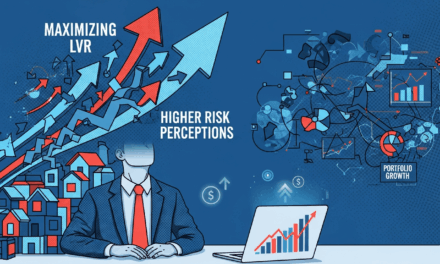Too Busy to Read? We’ve Got You.
Get this blog post’s insights delivered in a quick audio format — all in under 10 minutes.
This audio version covers: The Broker’s Guide to Ethical Lending in Australia: Green Mortgages, Compliance Frameworks, and NatHERS Rating Mastery
The Broker’s Guide to Ethical Lending in Australia: Green Mortgages, Compliance Frameworks, and NatHERS Rating Mastery
The Australian residential mortgage landscape is undergoing a significant transformation driven by increasing consumer demand for environmental, social, and governance (ESG) alignment. Specializing in ethical and sustainable finance is transitioning from a niche advantage to a strategic imperative for mortgage brokers operating in the $11.8 trillion residential property market `[1]`. This specialization requires mastery of specific product criteria, a robust understanding of institutional ethical screens, and rigorous adherence to regulatory compliance, particularly regarding the avoidance of ‘greenwashing.’
The market momentum is undeniable. Globally, cumulative lifetime issuance of sustainable debt instruments has exceeded USD 10 trillion, with approximately 75% of that volume materializing since 2021 `[2]`. This surge confirms the commercial viability and maturity of the sustainable finance ecosystem. For Australian brokers, successfully navigating this sector demands a dual focus: assessing the ethical conduct of the financial institution itself (Institutional Ethics) and verifying the sustainability performance of the underlying asset (Property Sustainability).
Article Navigation
- Step 1: Executive Summary: The Strategic Imperative of Sustainable Finance
- Step 2: The Australian Context of Ethical Residential Lending
- Step 3: Niche Green Mortgage Products and Financial Mechanics
- Step 4: Technical Criteria: Decoding Sustainability Eligibility
- Step 5: The Comprehensive Value Proposition: Quantifying Green Investment
- Step 6: Regulatory Compliance and the Greenwashing Challenge
- Step 7: Broker Action Plan: Integrating Green Lending Expertise
I. Executive Summary: The Strategic Imperative of Sustainable Finance
The reliance of Australian consumers on mortgage professionals is profound, with brokers arranging 75% of all new residential loans in 2024 “. This high market penetration establishes the broker as the essential gatekeeper in the dissemination of specialized green finance products. Consequently, the onus to ensure compliance and prevent misrepresentation rests heavily on the brokerage advisory process. The central compliance risk is greenwashing, where claims of sustainability are unsubstantiated or misleading. The Australian Securities and Investments Commission (ASIC) has foregrounded the necessity for “Truth in promotion” and demands that all claims relating to environmental benefits or future savings be supported by “reasonable grounds” `[3]`. Brokerages must develop technical mastery of metrics like the Nationwide House Energy Rating Scheme (NatHERS) to effectively substantiate these claims.
II. The Australian Context of Ethical Residential Lending
Effective counsel to eco-conscious clients requires the broker to clearly define and differentiate between the ethical screening of the lender and the demonstrable sustainability of the home itself. These two distinct dimensions often involve conflicting product outcomes that must be reconciled with the client’s primary financial and ethical motivations.
A. Differentiating Ethical Screens from Property Sustainability
Institutional Ethics (The ‘Lender Screen’)
Institutional ethics scrutinize the broader business activities of the financial provider. For clients deeply committed to sustainability, the financial institution’s stance on high-impact sectors, particularly fossil fuels, is a critical selection criterion. Some institutions have adopted strong exclusion policies. For instance, Bank Australia maintains a firm position against institutional lending to coal, gas, or oil extraction, or fossil fuel electricity generation, a commitment driven by customer preference for climate action `[4]`. Similarly, Australian Ethical employs screens to minimize investments in activities deemed negative, such as fossil fuels, nuclear power, and tobacco, while actively seeking out positive investments in renewables and healthcare `[5, 6]`.
A review of the lending environment reveals a clear dichotomy. While customer-owned banks and ethical fund managers actively exclude these sectors, many major Australian banks continue to fund fossil fuel projects. Data indicates that between 2016 and 2023, major banks have committed tens of billions of dollars to fossil fuel financing, a salient point for clients prioritizing institutional divestment `[7]`.
Product Sustainability (The ‘Asset Screen’)
The asset screen, conversely, is exclusively focused on the environmental performance and energy efficiency of the property used as collateral. Green Mortgages fall within this category, as they link the interest rate or fee structure directly to quantifiable, verifiable metrics of the home’s performance, such as its NatHERS rating `[8]`.
B. The Ethical Dilemma in Client Advising
The differentiation between institutional and asset ethics can lead to a fundamental conflict in product recommendation. A client may construct a new home achieving the highest NatHERS rating of 7.5 stars, thereby qualifying for a competitive green loan discount. However, that optimal green product rate might be offered exclusively by a major bank with known, substantial fossil fuel exposure `[7]`. Conversely, a smaller institution known for its stringent ethical screens may offer a Clean Energy Home Loan `[9]` but at a rate or with specific criteria that are slightly less competitive or appealing to the client’s core financial goals.
The broker’s responsibility is to navigate this conflict by meticulously documenting the client’s hierarchy of ethical priorities. The professional approach demands clarifying whether the paramount motivation is institutional alignment (selecting an ethically screened lender) or maximizing the reward for asset performance (securing the deepest discount tied to the NatHERS score). This crucial step ensures the broker satisfies their “best interests duty” by providing advice that reflects the client’s holistic, and sometimes conflicting, values.
C. Market Scale and the Growth Opportunity
The sustained resilience of the Australian residential property market, which recently reached a total value of $11.8 trillion and continues to experience momentum in national housing values `[1]`, provides a high-value backdrop for the expansion of sustainable products. Investor and owner-occupier demand for sustainability-related products is increasing, confirming a growing, specialized market segment `[3]`. Furthermore, industry analysis suggests that housing featuring verifiable green characteristics commands increased property value and is correlated with a decreased risk of mortgage default `[10]`. This provides a compelling financial narrative for brokers to present. However, the comprehensive financial valuation of green features across the market is currently constrained by limited verifiable data on established housing stock `[10]`.
III. Niche Green Mortgage Products and Financial Mechanics
Green mortgage products are highly specialized instruments designed to channel capital toward energy-efficient housing. Brokers must understand the specific segmentation and eligibility criteria that define these products.
A. Product Segmentation and Design
Green Mortgage products typically target three specific client actions: the purchase of a newly constructed, high-efficiency dwelling; the financing of new high-efficiency construction; or the funding of ambitious green upgrades or renovations to existing properties `[9]`. The primary incentive mechanism across the industry is a reduced interest rate, which may be applied to a variable rate for a period (e.g., 5 years) or a fixed rate (e.g., 3 years) `[9]`. Lender criteria, however, vary significantly in their stringency and verification requirements `[11]`.
Specific Product Examples
The market offers distinct products tailored to specific sustainability verification methods:
- **Bank Australia Clean Energy Home Loan:** This product is supported by the Federal Government-backed Clean Energy Finance Corporation (CEFC), lending strong institutional credibility to its green purpose `[9]`. It provides options for customers building, buying, or renovating a green home with a reduced rate structure `[9]`.
- **Great Southern Bank Green Home Offer:** This product explicitly links its discounted rate to the home achieving a minimum Nationwide House Energy Rating Scheme (NatHERS) rating of **7.5 stars or above** `[12]`. Crucially, this lender imposes a property age restriction, requiring the home, if existing, to have been constructed within the last 12 months `[12]`. Furthermore, the terms permit the revocation of the discount if the mandated NatHERS rating is not achieved following construction `[12]`.
- **Loans.com.au Green Home Loan:** This product emphasizes the common property age restriction, requiring the property to be less than 12 months old, in addition to meeting lender-specific building and eligibility requirements `[11]`.
The table below summarizes the critical differentiating factors necessary for a broker’s rapid market segmentation:
| Lender | Product Name | Minimum Sustainability Criterion | Property Age Restriction | Primary Incentive | Source Reference |
|---|---|---|---|---|---|
| Bank Australia | Clean Energy Home Loan | Green Home/Ambitious Upgrade (Lender specific criteria) | N/A (Build/Renovate options available) | Reduced variable rate (5 years) or fixed rate (3 years) | `[9]` |
| Great Southern Bank | Green Home Offer | NatHERS Rating of 7.5+ (from accredited assessor) | Constructed within the last 12 months (existing properties) | Discounted variable rate | `[12]` |
| Loans.com.au | Green Home Loan | Lender-specific criteria/building requirements | Less than 12 months old | Discounted interest rate | `[11]` |
IV. Technical Criteria: Decoding Sustainability Eligibility
The credibility of a Green Mortgage product is intrinsically tied to objective, third-party verification. The Nationwide House Energy Rating Scheme (NatHERS) serves as the indispensable standard metric in the Australian market.
A. The Nationwide House Energy Rating Scheme (NatHERS)
NatHERS is the dominant assessment tool, rating a building’s thermal performance on a scale of one to 10 stars, reflecting its energy efficiency for heating and cooling `[8, 12]`. For a property to qualify for niche green products, it must secure a rating significantly higher than the average. While some products target 7 stars or higher `[8]`, the industry trend for discounted products, as exemplified by Great Southern Bank, requires a minimum of **7.5 NatHERS stars** from an accredited assessor `[12]`.
Crucially, when assessing apartments, the required rating is based solely on the thermal performance of the individual unit, disregarding the building’s overall communal rating `[12]`. This ensures the borrower is rewarded for the energy performance they can directly control and benefit from.
B. Standardisation vs. Lender Differentiation
The increasing stringency of national and state building codes presents a developing issue for the green mortgage niche. In New South Wales (NSW), the Building Sustainability Index (BASIX) is the mandatory assessment tool for residential buildings, targeting efficiency in water, energy use, and thermal performance `[13]`. Following updates in October 2023, the BASIX standards aligned with the National Construction Code 2022, raising the minimum thermal performance standard for new residential buildings from an average of 5.5–6 stars to a mandatory **7 stars NatHERS** `[13]`.
This regulatory standardisation means that a 7-star home, while energy efficient, is increasingly becoming the expected minimum standard for new construction, particularly in NSW. Lenders requiring a 7.5-star rating, therefore, are establishing their green product eligibility threshold *above* the new regulatory floor. This differentiation is critical: by demanding performance beyond mandatory compliance, lenders maintain the integrity of their offerings, ensuring the discounted rate genuinely rewards highly sustainable construction and is not subject to regulatory criticism for rewarding mere adherence to the National Construction Code.
C. Eligibility Restrictions and the Data Gap
A key operational constraint for green mortgages is the restriction on the age of the property. Lenders routinely require that existing properties must have been constructed within the **last 12 months** to be eligible `[11, 12]`. This restriction is necessitated by the current data environment. New builds are required to obtain verifiable NatHERS certification as part of the approval process, providing lenders with the objective, third-party data needed to assess risk and determine eligibility.
Industry observers note that the financial market’s ability to accurately value green features and extend green finance to established housing stock is significantly hindered by the absence of standardized NatHERS certification for existing properties `[10]`. The data gap for established housing stock confines the current niche market almost exclusively to new construction and recent sales. Future market expansion will depend on the development of standardized, cost-effective retro-fitting assessment tools to bridge this gap and unlock the potential of older homes.
Specific state requirements must also be noted. The Australian Capital Territory (ACT) imposes a heightened verification standard, requiring applicants to provide both a 7.5+ NatHERS certificate *and* an ACT Energy-Efficiency Rating certificate, also showing a minimum rating of 7.5 `[12]`.
V. The Comprehensive Value Proposition: Quantifying Green Investment
The broker’s advisory role extends beyond securing a discounted interest rate; it requires providing a detailed financial model that justifies the typically higher upfront capital cost associated with energy-efficient features (such as solar panels, double glazing, and improved insulation). The goal is to demonstrate a tangible, positive return on investment (ROI).
A. Calculating Net Financial Benefits
The financial argument for a Green Star Home involves balancing the immediate increase in mortgage repayments against the recurring reduction in operational costs. Analysis by the Green Building Council of Australia (GBCA) indicates that the required inclusions for a highly efficient home (e.g., improved insulation, water-efficient fixtures) typically increase monthly loan repayments by between **$38 and $84** `[14]`.
However, this increased cost is substantially offset by the immediate reduction in utility bills. Living in a Green Star Home typically reduces energy consumption by **56–60%**, translating to energy bill savings of **$90 to $140 per month** `[14]`. This results in a net positive cash flow for the borrower from day one, even before accounting for the discounted interest rate of the green loan. For a home meeting the higher BASIX standards in NSW, the average energy bill savings are projected at **$1,070 per year** `[13]`.
B. Lifetime Financial Impact and Reduced Risk
The most compelling justification for the green investment lies in the long-term compounding effects. By securing a discounted rate and maintaining their repayments at the original level (effectively reinvesting their energy and interest savings), clients can dramatically accelerate their debt repayment.
KPMG analysis supports this position, projecting significant lifetime interest savings, estimating up to **$115,000 in interest costs** for an average-sized home in Canberra, and **$95,000 in Melbourne**, resulting in the green loan outperforming the remaining principal of a conventional loan within approximately 6.5 to 8.5 years `[14]`. This ability to accelerate loan repayment aligns with general mortgage optimization principles, where significant rate reductions and consistent extra repayments allow borrowers to save massive amounts of interest and reduce the loan term by several years `[15]`.
Furthermore, green housing features are associated with an improved financial profile for the borrower. The enhanced energy efficiency reduces running costs, freeing up disposable income and bolstering the borrower’s financial resilience, which is linked to a decreased risk of mortgage default `[10]`.
The quantified financial arguments are summarized below:
| Financial Metric | Typical Monthly Cost Increase (Green Features) | Typical Monthly Energy Savings (56-60% Reduction) | Net Monthly Cash Flow (Pre-Loan Discount) | Lifetime Interest Savings Potential (KPMG Analysis) | Source Reference |
|---|---|---|---|---|---|
| Range (AU$) | $38 – $84 | $90 – $140 | Positive net saving (Variable) | Up to $115,000 | `[14]` |
| Other Savings | N/A | NSW BASIX average $1,070 per year on energy bills | N/A | N/A | `[13]` |
VI. Regulatory Compliance and the Greenwashing Challenge
The increasing demand for sustainability-related financial products has heightened the risk of greenwashing—where an entity misrepresents the environmental extent or benefit of a product `[3]`. For mortgage brokers, promoting or advising on green mortgages triggers regulatory obligations under the *Corporations Act 2001* and the *ASIC Act 2001*. Compliance with these obligations is paramount to maintaining professional integrity and avoiding legal sanctions.
A. ASIC’s Mandate and Statutory Prohibitions
ASIC enforces general prohibitions against engaging in dishonest, misleading, or deceptive conduct in relation to a financial product or service `[3]`. These prohibitions apply directly to the statements and conduct of brokers when presenting green finance options.
A specific area of regulatory focus is representations made about **future matters**. A claim regarding a future outcome—such as projected energy bill savings over the long term, or a guaranteed emissions reduction target—must be supported by reasonable grounds `[3]`. If the broker or the promoter of the product lacks reasonable grounds to support the future claim, the representation may be deemed misleading `[3]`. This elevates the importance of utilizing objective data, such as NatHERS certificates and verifiable third-party reports (e.g., GBCA/KPMG analysis) when quantifying benefits.
B. Greenwashing Risk Mitigation: The Broker’s Liability for Repetition
Although the lender (the product issuer) holds primary responsibility for the Product Disclosure Statement (PDS), the broker, through their advertising, promotion, and advice, also assumes significant responsibility. Regulatory guidance (such as RG 234) applies to the advertising of credit products, requiring “Truth in promotion” and “Clarity in communication” `[3]`.
The broker must exercise due diligence regarding the underlying facts of the product. Simply relaying unsubstantiated claims made by a lender about future savings or the absolute ethical nature of the fund exposes the broker to liability for misleading conduct. The necessary professional standard requires the broker to verify that:
- **The product is “true to label”:** The green product’s name and marketing materials must accurately reflect the substance of the product and its eligibility criteria `[3]`. A loan marketed as a “green” product must demonstrably reward performance that exceeds regulatory minimums, such as demanding 7.5 NatHERS stars when 7 stars is the regional baseline `[12, 13]`.
- **Vague terminology is avoided:** General or unsubstantiated jargon, such as ‘ethical investing’ or ‘socially responsible,’ must be clearly explained using the specific definitions and exclusions documented in the lender’s PDS and regulatory materials `[3]`.
- **Consistency of disclosure is maintained:** All information, whether provided verbally, in marketing flyers, or via digital channels, must be consistent with the formal regulatory documentation `[3]`.
VII. Broker Action Plan: Integrating Green Lending Expertise
Operationalizing ethical and green lending expertise requires establishing rigorous advisory workflows and specialized documentation requirements.
A. Establishing a Technical Advisory Workflow
The advisory process must be structured to capture, verify, and quantify sustainability criteria effectively:
- **Client Motivation Assessment:** Determine the client’s core ethical driver. This involves clarifying if the primary goal is alignment with institutional ethical screens (e.g., fossil fuel exclusions) or maximization of financial incentives linked to asset performance (e.g., NatHERS score).
- **Eligibility Verification and Data Collection:** For new construction or recently completed properties, the broker must immediately request and verify the NatHERS Certificate provided by the accredited assessor. The critical threshold of 7.5 stars (or other lender-specific minimums) must be explicitly confirmed against the lender’s current eligibility requirements `[12]`.
- **Comprehensive Financial Modeling:** The advice must move beyond the interest rate discount. The broker should model the **net cash flow benefit** by integrating the quantified energy savings (e.g., $90–$140 per month) with the reduced loan repayment cost. This demonstrated net positive cash flow substantiates the economic viability of the green investment `[14]`.
- **Compliance Documentation:** All claims regarding future savings or environmental benefits must be substantiated by sourcing official documentation (e.g., NatHERS certificates, GBCA/KPMG financial analysis). This process fulfills the regulatory obligation to demonstrate “reasonable grounds” for all future matter representations `[3]`.
B. Specialized Documentation and Due Diligence Checklist
Green mortgage applications require documentation beyond standard proof of identity, income, and assets `[16]`.
Mandatory Green Documentation:
- **NatHERS Certificate:** Required from an accredited assessor, confirming the minimum star rating (often 7.5 or above) required for the specific product `[12]`.
- **BASIX Certificate (NSW):** Mandatory for NSW properties, confirming adherence to 7-star thermal performance, water, and energy efficiency standards `[13]`.
- **ACT Energy-Efficiency Rating Certificate:** Required in addition to the NatHERS certificate for properties in the ACT `[12]`.
- **Proof of Construction Date:** Necessary to confirm the property meets common age restrictions (e.g., constructed within the last 12 months) `[11, 12]`.
Ethical Due Diligence Documentation:
If institutional ethics were a core client priority, the broker must file documented evidence of the recommended lender’s ethical lending policy, particularly concerning fossil fuel or other exclusion criteria, ensuring transparency `[4, 7]`.
C. ASIC Greenwashing Risk Mitigation Checklist
Adhering to this operational checklist transforms general ASIC regulatory warnings into actionable steps for the brokerage:
| Greenwashing Risk Area | ASIC Guidance Focus | Broker Action Required (Pre-Promotion/Advice) | Source Reference |
|---|---|---|---|
| **Vague Terminology** | Avoid broad, unsubstantiated statements; clarify jargon. | Define all ethical terms (e.g., ‘socially responsible’) using the lender’s specific PDS definitions. | `[3]` |
| **Truth in Promotion** | Ensure product label aligns with the underlying strategy. | Confirm the property genuinely qualifies for the rate reduction (e.g., 7.5 NatHERS stars verified) before marketing the product to the client. | `[3, 12]` |
| **Future Matters Claims** | Representations about future outcomes (savings) must have reasonable grounds. | Utilize NatHERS data, Green Star/GBCA studies, or KPMG analysis to quantify and qualify savings projections `[13, 14]`. Never guarantee savings without supporting data. | `[3]` |
| **Documentation Integrity** | Disclosure must be easy to locate and consistent across all mediums. | Keep all NatHERS/BASIX certificates and lender compliance documents in the client file to support the eligibility and savings claims. | `[3]` |
VIII. Conclusion and Recommendations
The ethical and green mortgage sector represents a vital evolutionary step in Australian residential finance. Success in this niche relies on highly specialized knowledge that integrates financial advice with verifiable sustainability metrics and stringent regulatory adherence.
Conclusions
- **Niche Definition:** The Australian green mortgage niche is defined by performance thresholds that consistently exceed new construction regulatory minimums, typically requiring a **7.5-star NatHERS rating** for discounted rates, distinguishing truly high-performing homes from standard compliant builds.
- **Dual Compliance Mandate:** Brokers must manage the inherent conflict between institutional ethical alignment (lender fossil fuel policy) and product performance (discounted rate for NatHERS achievement). Comprehensive documentation of the client’s primary value driver is non-negotiable under the best interests duty.
- **Data Dependency:** The market is currently limited to new construction due to the reliable availability of NatHERS certification data for properties less than 12 months old. Future expansion into retrofitting loans requires the standardization of energy rating assessments for established housing stock.
- **Greenwashing as a Structural Risk:** ASIC views unsubstantiated future claims (such as savings projections) as a primary greenwashing risk. The broker’s liability, even when relaying issuer information, necessitates robust evidence—utilizing quantifiable, verified data on energy savings and lifetime cost reduction to provide advice based on reasonable grounds.
Recommendations for Brokerage Expertise
The time to specialize is now. Embrace these strategies to lead the sustainable finance conversation in your market:
1. **Mandate Technical Certification:** Brokerage training programs should mandate detailed education and accreditation in the mechanics of NatHERS and BASIX, ensuring all advisers can interpret and verify these technical certificates as easily as they verify income statements.
2. **Integrate ROI Modeling:** Implement mandatory financial modeling protocols that quantify the net positive cash flow derived from the convergence of energy savings and discounted rates. The value proposition must be communicated as a lifetime financial advantage, not merely a short-term rate reduction.
3. **Establish a Compliance Checkpoint:** Institute a mandatory compliance checkpoint in the green loan submission process, utilizing the Greenwashing Risk Mitigation Checklist, to ensure all claims are supported by verifiable documentation (NatHERS certificate) before the product is presented to the client or the application is submitted to the lender.
Rethink Your Strategy: Download the Green Lending Checklist





